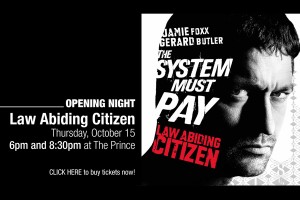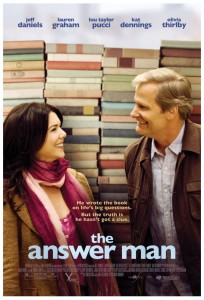Local Anesthetic: Film Festivals Part IV
 “We want to show movies that won’t be seen at the local mallplex,” drunkenly exclaimed Harlan Jacobson, the artistic director of the 18 ½ Philadelphia Film Festival and a film community legend. It was awkward enough being a film critic at an invite-only party taking place at an upscale club. No matter how you try to polish us, we’re still going to be a bunch of nerds carrying around a backpack and a laptop. Even in this case, where we were surrounded by a slew of overdressed women in their mid 40s, swarming the waters, it felt more like a high school dance where the boys hug the wall and the girls look bored and disappointed. At least, in this case, they had the option of distracting themselves with an open bar.
“We want to show movies that won’t be seen at the local mallplex,” drunkenly exclaimed Harlan Jacobson, the artistic director of the 18 ½ Philadelphia Film Festival and a film community legend. It was awkward enough being a film critic at an invite-only party taking place at an upscale club. No matter how you try to polish us, we’re still going to be a bunch of nerds carrying around a backpack and a laptop. Even in this case, where we were surrounded by a slew of overdressed women in their mid 40s, swarming the waters, it felt more like a high school dance where the boys hug the wall and the girls look bored and disappointed. At least, in this case, they had the option of distracting themselves with an open bar.
Throughout his speech, Harlan repeated the phrase mallplex, trying to position the festival as a bastion of independent film spirit, boasting the cream of the crop from Cannes, Sundance, and Toronto. I didn’t have the heart to tell him that opening with a movie as mainstream as F. Gary Gray’s morally repugnant and inadvertently hilarious Law Abiding Citizen was not a good omen. If there was ever a movie that was made for the local mallplex, it’s Law Abiding Citizen, but since the movie was shot in Philadelphia and featured a wordless cameo from Mayor Nutter, the standard homer Philly pride kicked in.
 This was true at April’s festival where a totally forgettable, middling movie like The Answer Man, (which the director admitted was only shot in Philadelphia because the tax breaks were better than in LA), the festival’s centerpiece film, got such an oddly enthusiastic reaction, to the point where during the screening another critic asked me if we’d entered The Twilight Zone. Outside of the festival hype, The Answer Man was totally ignored at the box office and scampered off into the oblivion. There’s an eagerness for an audience to fall in love with some hidden gem at a film festival, especially such a small festival. The 18 ½ Festival was made up of only 35 films and took place over only 4 days (the result of a split between the main financiers of the far larger April festival), so you’d hope for the cream of the crop, instead of the moldy dregs of the previous larger festivals. The main reasons for the uninspiring line-up is that the major films have already had their major splash earlier in the year (Sundance in January, Cannes in May, and Toronto in September) and at Philadelphia festivals, no one is there to buy any films, so there’s no incentive to spend money on sending a print.
This was true at April’s festival where a totally forgettable, middling movie like The Answer Man, (which the director admitted was only shot in Philadelphia because the tax breaks were better than in LA), the festival’s centerpiece film, got such an oddly enthusiastic reaction, to the point where during the screening another critic asked me if we’d entered The Twilight Zone. Outside of the festival hype, The Answer Man was totally ignored at the box office and scampered off into the oblivion. There’s an eagerness for an audience to fall in love with some hidden gem at a film festival, especially such a small festival. The 18 ½ Festival was made up of only 35 films and took place over only 4 days (the result of a split between the main financiers of the far larger April festival), so you’d hope for the cream of the crop, instead of the moldy dregs of the previous larger festivals. The main reasons for the uninspiring line-up is that the major films have already had their major splash earlier in the year (Sundance in January, Cannes in May, and Toronto in September) and at Philadelphia festivals, no one is there to buy any films, so there’s no incentive to spend money on sending a print.
 The result was that instead of the latest from Pedro Almodóvar (Broken Embraces), the Coen brothers (A Serious Man), or Terry Gilliam (The Imaginarium of Doctor Parnassus), we get a sequel to the Luc Besson produced District 13, a heavily edited version of John Woo’s Red Cliff (cut from 278 minutes to 150 minutes), and another Americanization of a formerly great foreign director with Lukas Moodysson’s Mammoth. None of this is a surprise, smaller festivals take what they can get, basically whatever the studio offers. It’s not unheard of for a studio to tell a programmer that they can have a film they covet only if they show a film that nobody likes and needs the exposure. If, instead of a festival, the studio was offering that same deal to a theater owner, that maneuver would be called block-booking, outlawed more than 50 years ago. But programmers don’t have much power; they know they’re offering a product that couldn’t sell 15 tickets once the movie officially opens theatrically
The result was that instead of the latest from Pedro Almodóvar (Broken Embraces), the Coen brothers (A Serious Man), or Terry Gilliam (The Imaginarium of Doctor Parnassus), we get a sequel to the Luc Besson produced District 13, a heavily edited version of John Woo’s Red Cliff (cut from 278 minutes to 150 minutes), and another Americanization of a formerly great foreign director with Lukas Moodysson’s Mammoth. None of this is a surprise, smaller festivals take what they can get, basically whatever the studio offers. It’s not unheard of for a studio to tell a programmer that they can have a film they covet only if they show a film that nobody likes and needs the exposure. If, instead of a festival, the studio was offering that same deal to a theater owner, that maneuver would be called block-booking, outlawed more than 50 years ago. But programmers don’t have much power; they know they’re offering a product that couldn’t sell 15 tickets once the movie officially opens theatrically
 That’s why genial, but uninspiring movies like Good Hair, with Chris Rock giving us an overlong lesson on African American hair get a “Centerpiece” screening at the festival ($15), even if it had already opened to mediocre business in NY + LA a week previous. It’s why smaller festivals like Philadelphia are chock full of 2 year old foreign films that you’ve never heard of (The Silence Before Bach), dead-on-arrival films where the production company went belly up (Tenure), and films where the studio has no faith in it or idea how to market it and needed some sort of exposure (The Men Who Stare At Goats). The movies from the festival that are worth your time are unlikely to get the proper attention, the hilarious A Town Called Panic, an expanded version of an antic French animated show, shot like Mr. Bill, but with the plastic toy characters screaming virtually every line and the desperate to find a distributor Shadow Billionaire, a documentary about the late DHL magnate Larry Hillblom and his sexual proclivities which caused a major legal squabbling over his will.
That’s why genial, but uninspiring movies like Good Hair, with Chris Rock giving us an overlong lesson on African American hair get a “Centerpiece” screening at the festival ($15), even if it had already opened to mediocre business in NY + LA a week previous. It’s why smaller festivals like Philadelphia are chock full of 2 year old foreign films that you’ve never heard of (The Silence Before Bach), dead-on-arrival films where the production company went belly up (Tenure), and films where the studio has no faith in it or idea how to market it and needed some sort of exposure (The Men Who Stare At Goats). The movies from the festival that are worth your time are unlikely to get the proper attention, the hilarious A Town Called Panic, an expanded version of an antic French animated show, shot like Mr. Bill, but with the plastic toy characters screaming virtually every line and the desperate to find a distributor Shadow Billionaire, a documentary about the late DHL magnate Larry Hillblom and his sexual proclivities which caused a major legal squabbling over his will.
These two films are small fish in a small pond, which should be the whole point of a film festival, but they end up as just filler between the attention-grabbing nothing movies surrounding them. And it’s not that I blame Harlan Jacobson for anything he had to do or say. He’s a creative type stuck being a salesman and it’ll take a few drinks before he finds a way to believe in his product.



